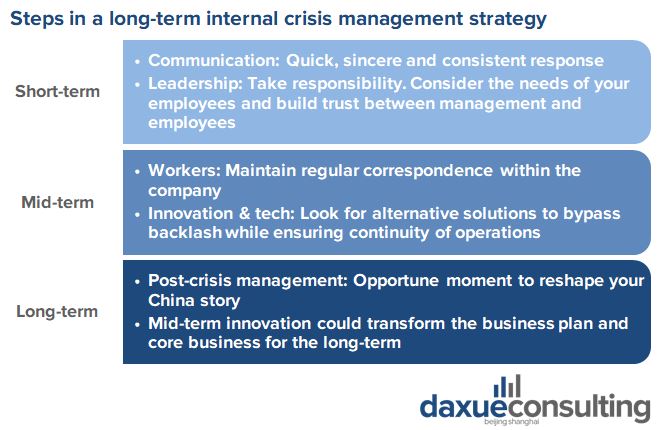Crisis management in China

What a project on crisis management in China may entail
- Monitoring to anticipate a crisis
- Consumer research and sentiment analysis to understand any sensitivities to navigate
- Ad-hoc crisis management to quickly navigate the crisis situation and reduce impact
- Marketing campaign evaluation to perfect your brand’s marketing message during crisis management
- Post-crisis services to turn crisis management into business turn-around
- Post-crisis brand health check to monitor the brand perception
What is crisis management?
Crisis Management is the art of dealing with a sudden event that threatens both internal operation and external stakeholders of an organization. A crisis includes sudden and unexpected events, which may lead to an unstable situation in the organization. As a country with unique and often unforeseeable challenges, a plan for crisis management in China is necessary for the longevity of operations.
Types of Crisis
There are internal and external crisis that companies in China may encounter. Though there are similarities, they require unique strategies.
External crisis in China
External crisis management in China includes responses to natural disasters, public health crises like SARS or COVID-19 epidemics, and crisis of malevolence. Necessary actions of external crisis management require companies to be socially conscious and have effective communication with both employees and consumers.
Internal crisis in China
Internal crisis management in China includes responses to financial crisis, technology crisis, deception crisis, workplace violence, confrontation crisis, and organizational misdeeds. In China, marketing mishaps regarding political boundaries and cultural sensitivities are often a source of internal crisis. Necessary actions of internal crisis include showing care for employees, continuous communication, and quick response.
External crisis management in China
From analysis of leading brand’s crisis management strategies in China during the SARS and COVID-19 outbreaks, we identified the main steps to deal with an external crisis in China. While the Chinese media landscape changed significantly, and Chinese consumers are becoming stricter, companies are expected to be more cautious and respond faster than ever.
Five key steps of external crisis management
- Ensure business continuity while taking care of your employees. Combining attention to the health of your employees and the continuity of your operations involves agility and expenses. With expertise in the insurance market and healthcare sector in China, Daxue consulting provides tailored recommendations about ways to safeguard employee’s safety and rights in China.
- Consistent internal communication with employees is critical to ensure business continuity and satisfy employees’ psychological needs. Maintain regular correspondence within the company to build trust between the management and employees. Employee morale is at risk during a crisis, positive and frequent internal communication is necessary.
- Listen to your customers to adapt marketing and communication. New demands always rise during a crisis, and businesses should be a solution to these practical issues. Our market watch team acutely provided updated insights tailored to a broad span of industries during the COVID-19 crisis in China. In addition, to better understand how consumers may feel or react, daxue consulting research team performs social media listening to investigate what is being said online about your brand or your market category in China.
- Provide consumers a sense of security. Insurance is a reoccurring element in the COVID-19 crisis management strategies. Providing insurance, even free insurance for a limited amount of time, shows customers support.
- Show corporate social responsibility by providing support, whether financial support, donations of materials or time. Answer the question: ‘How can we offer help?’ For business, an external crisis must be seen as a ‘responsibility’ rather than an ‘opportunity.’ By doing so, it will help you to build a responsible brand image in China.
Short term and long-term outlook after an external crisis in China

Internal crisis management in China
While an external crisis, although often damaging to business, can be leveraged to improve brand image. On the other hand, an internal crisis in China is more likely to be considered the fault of a company. Therefore, it could damage your business without such underlying benefits.
We strongly recommend companies which want to enter the Chinese market to come with a proactive internal crisis management strategy in hand. To do so, we are committed to giving the best practices, do’s and don’ts to make your business overcome the challenges of the Chinese market:
Four key steps of internal crisis management
- Quick responses can tone down negative public or in-company discourses. A response to negative comments, which may include apologies and taking responsibility, can curb negative attention from consumers. Prompt internal and external communication are both needed in this process.
- Sincerity is key. After a promotion that was seen as mocking Chinese people’s use of chopsticks, and leak from Gabbana’s private chat showing offensive comments on China, D&G apologized several times. The brand first said the account had been hacked. Then, they retracted the apology video from their account, displaying inconsistency in their communication. These messages caused further backlash from the Chinese netizens. Unfortunately, the longer a brand waits to give a sincere apology, the more backlash they will receive.
- Think outside of the box to seek alternative solutions. One example is airlines using airport codes on their website instead of ‘country names’ to comply with the ‘One China’ policy and avoid backlash from markets both inside and outside of China.
- Craft your post-crisis strategy. If Chinese media and netizens seem quiet after the crisis, they are still paying close attention to the parties involved. Take advantage of this silent audience to reshape your China story in a positive narrative.
Short term and long-term strategic outlook after an internal crisis in China

Additional methods we leverage to build a buttoned-up crisis management strategy in China
China demands its own set of tools and responses to deal with increasingly discerning consumers and merciless online Chinese landscape. At daxue consulting, we developed a bird’s eye view of navigating the Chinese market. Therefore, our China crisis management strategy recommendations for your brand are powered these research methods:
- Consumer Research in China
- Market Analysis in China
- Sentiment Analysis in China
- Online Market Research in China
- China Market Entry
- Branding in China
- Marketing Strategy in China
- Agile Strategy in China
We combine these areas of knowledge with our expertise of handling uncertainty while doing business in China.
Does your enterprise need a China crisis management strategy?
To get started on your crisis management plan, contact our project team at dx@daxueconsulting.com.

